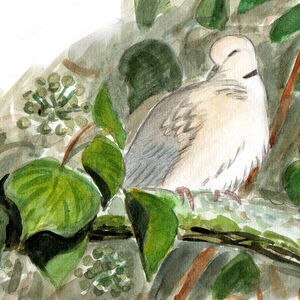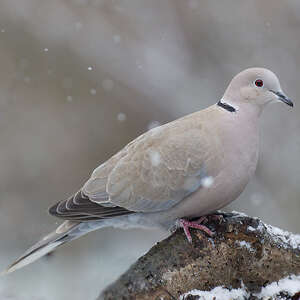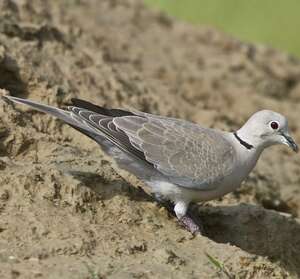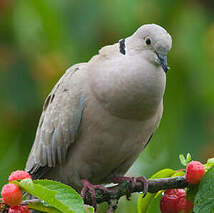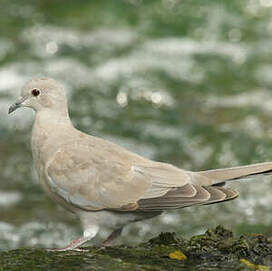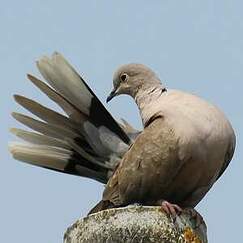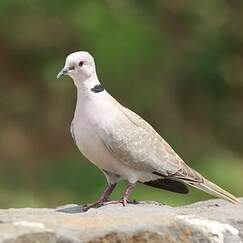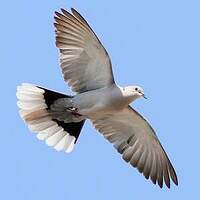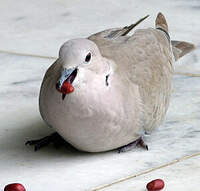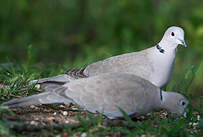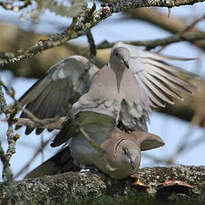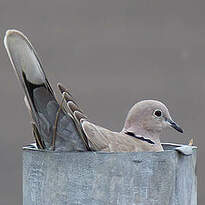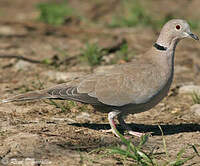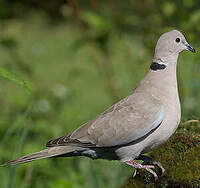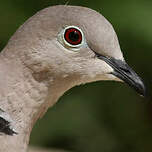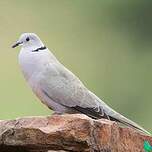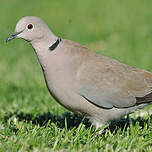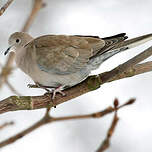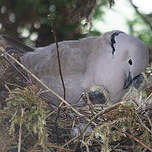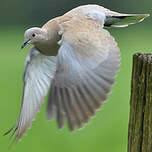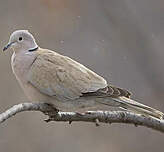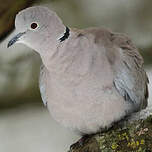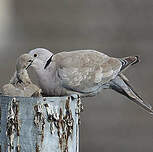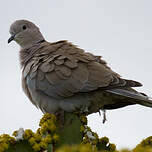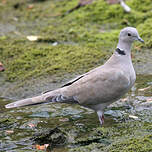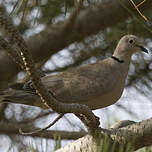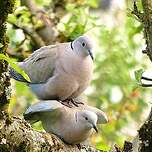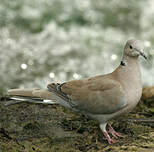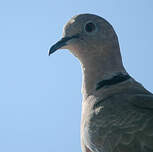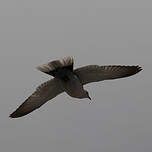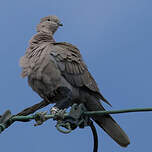Eurasian Collared Dove
Streptopelia decaocto - Tourterelle turque
Identification
The Eurasian Collared Dove is a slender little pigeon, living close to humans and their activities. With its relatively long tail and short, rounded wings, it can be mistaken for a sparrowhawk in flight, which can briefly send small birds into a panic when it unexpectedly appears. It has a light plumage. The upper parts (body, wing coverts and central rectrices) are a pale fawn colour, appearing uniform from far away. But up close, it is visible that some feathers have a darkened shaft and are lightly fringed with pale. The remiges are dark brown and light grey plumes can be seen around the wrist. The underparts are pale sand. During the mating season, the head, neck and body take on a faint pink shade. A distinct, black half-collar appears at the back of the neck, sometimes outlined with white. The rectrices, excluding the central ones, are bi-coloured, black on the proximal half and white on the distal part, which can be quite visible in flight just like the underside of the wings. The iris is red-blood, the eye surrounded by white and the beak black. The legs are rosy. The juvenile has the upper feathers clearly fringed with fawn. The half-collar is absent and the iris is brown while the legs are brownish-reddish.
Subspecific information monotypic species
Foreign names
- Tourterelle turque,
- Tórtola turca,
- rola-turca,
- Türkentaube,
- balkáni gerle,
- Turkse Tortel,
- Tortora dal collare,
- turkduva,
- Tyrkerdue,
- hrdlička záhradná,
- hrdlička zahradní,
- Tyrkerdue,
- turkinkyyhky,
- tórtora turca,
- Tyrkjadúfa,
- sierpówka (zwyczajna),
- gredzenūbele,
- turška grlica,
- Кольчатая горлица,
- シラコバト,
- 灰斑鸠,
- 悲斑鳩,
Voice song and cries
The song of the Eurasian Collared Dove is a loud koukouh kou, often repeated. The first two syllables are the same, the second is slightly drawn-out, and the third is slightly spaced and with a slightly lower tone. The flight call, often emitted when perched, is a nasal sigh, initially rising and then descending, indescribable.
Habitat
In its Indian homeland, the Eurasian Collared Dove was a bird of semi-deserts and other arid zones. The phenomenal, demographic, and geographical expansion it experienced during the 20th century is already proof of a change in its behavior.
Behaviour character trait
The Eurasian Collared Dove is a friendly species due to it's proximity with humans. It can be seen daily, usually in pairs since their unions are steady, and all year long as they are sedentary.
Its song participates in the aural ambience of hamlets, villages and other urban outskirts. Its song can become tedious as it's often repeated throughout the day. It generally keeps company to the chickens in the coops since there are always some grains to be gleaned. In the same way, it will willingly frequent the feeding stations where seeds are dispersed, as well as grain silos and other grain stores. It usually feeds on the ground, but is capable of climbing onto feeders, window sills or other places to find its food. During the nuptial season, the male performs nice nuptial flights, from a rooftop, a tree or other exposed perch. It ascends while beating its wings noisily, then glides to the female, wings and tail spread and emitting its nasal cry. A nuptial parade follows, in which the couple executes jumps facing each other, up to one meter in height, while beating their wings loudly, repeating the motion as needed. They are then followed by flight, punctuated with flapings of the wings. It's touching to see the partners kissing each other, perched side by side on a wire, branch or gutters. This is a species that should be easy to tame.Flight
The flight of the Eurasian Collared Dove is a fast and direct flight due to the energetic flappings of the wings. The rounded tips of the wings are related to the sedentary lifestyle of the species. During mating displays, it willingly glides for extended periods, wings and tail spread fully, when it descends towards a perch at the end of its demonstration.
Dietfeeding habits
The Eurasian Collared Dove is mainly granivorous and looks for its food on the ground. Cereal or other cultivated plant seeds, such as buckwheat, always have a place of choice in its diet, but the composition can vary depending on the region, sampling wild grass, polygonaceae, brassica seeds, etc.
In the spring, the young shoots and some small insects are part of the diet, and then some berries in summer, but in an anecdotal way. Its daily ration is about 20g of food. It drinks by sucking, without head movements to swallow.Reproduction nesting
In temperate regions, the Eurasian Collared Dove predominately breeds from March to October. In this span of time, it can have multiple successions of breeding.
They can even overlap and in some cases, we have found laying in nests that the previous clutch had not yet departed from. It goes without saying that the species is prolific and its productivity must be a major demographic parameter in explaining its expansive nature. The nest is very pigeon-like. It is a small, simple platform made of dry twigs and built in a tree, dense bush, hedge... The female lays two smooth, white eggs in it. The incubation period lasts around 14 days, with both parents attending to it. The chicks are nestlings. The parents feed them pre-digested grain mixtures (pigeon milk) and the youngs leave the nest after 18 to 19 days. They are able to fly at three weeks and become independent at 30 or 40 days. It would be interesting to mark adult females and follow their reproductive trajectories over a season. Without that, we can never be fully certain of the amount of successive clutches since one adult female looks much like the other.Geographic range
The Eurasian Collared Dove is native to India, Sri Lanka, and Myanmar. The species experienced an exceptionally intense expansion during the 20th century which enabled it to occupy all of western Eurasia to temperate latitudes and also Maghreb. In Fenno-Scandia, it has reached and surpassed the Arctic Circle, a testament to its great adaptability. The species was introduced to the Bahamas in the mid-1970s, and from Florida it began to conquer the North American continent. Now, it extends its territory over most of the United States, with greater progress in the west where it has widely encroached on Canada and reached Alaska. It has started to reach the South American continent (with some data from Colombia and Ecuador). It has also been introduced to Japan.
Threats - protection
IUCN conservation status
concern
in the Wild
threatened
evaluated
The Eurasian Collared Dove is a common and widely distributed species wherever it is found. It is a very dynamic species demographically and has conquered new and vast territories. And the expansion continues despite a rather high adult and juvenile mortality. It is not at all threatened.
Sources of information
- IOC World Bird List (v14.1), Gill, F and D Donsker (Eds). 2024-04-18.
- Pigeons and Doves, David Gibbs, Eustace Barnes and John Cox
- Birds of the World, The Cornell Lab of Ornithology
- xeno-canto, Sharing bird sounds from around the world,
Other sources of interest
 Specification sheet created on
15/07/2023 by Jean François
Specification sheet created on
15/07/2023 by Jean FrançoisTranslation by AI Oiseaux.net
published: 25-10-2020 - Updated: 05-11-2020
© 1996-2024 Oiseaux.net
- Accipitriformes
- Aegotheliformes
- Anseriformes
- Apodiformes
- Apterygiformes
- Bucerotiformes
- Caprimulgiformes
- Cariamiformes
- Casuariiformes
- Charadriiformes
- Ciconiiformes
- Coliiformes
- Columbiformes
- Coraciiformes
- Cuculiformes
- Eurypygiformes
- Falconiformes
- Galliformes
- Gaviiformes
- Gruiformes
- Leptosomiformes
- Mesitornithiformes
- Musophagiformes
- Nyctibiiformes
- Opisthocomiformes
- Otidiformes
- Passeriformes
- Pelecaniformes
- Phaethontiformes
- Phoenicopteriformes
- Piciformes
- Podargiformes
- Podicipediformes
- Procellariiformes
- Psittaciformes
- Pterocliformes
- Rheiformes
- Sphenisciformes
- Steatornithiformes
- Strigiformes
- Struthioniformes
- Suliformes
- Tinamiformes
- Trogoniformes

